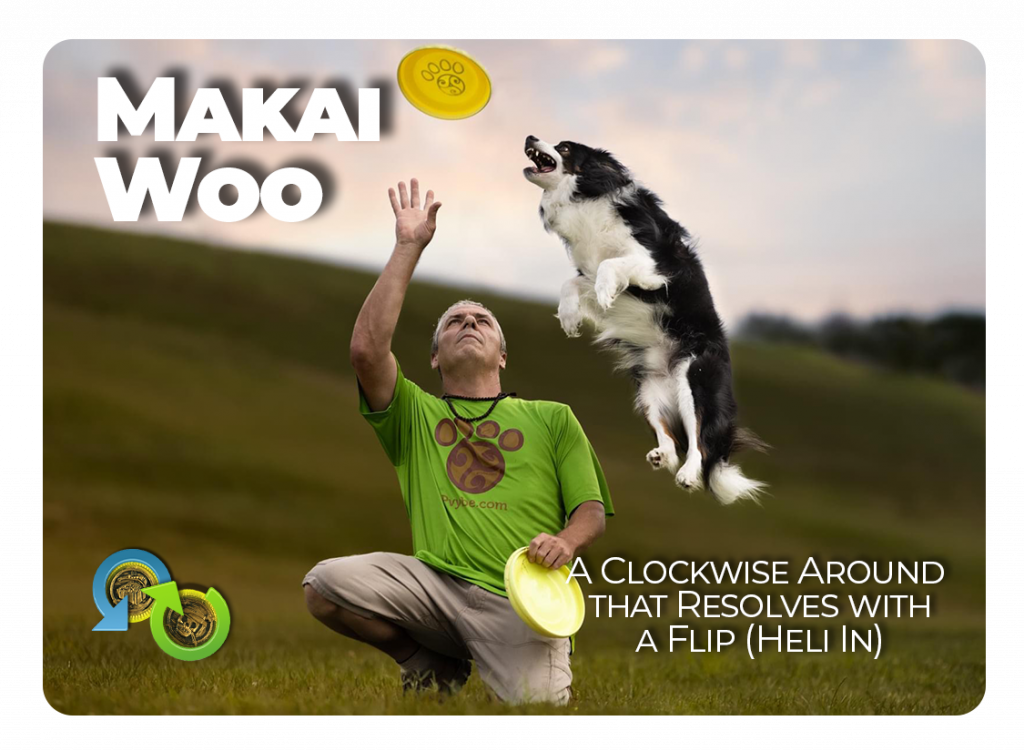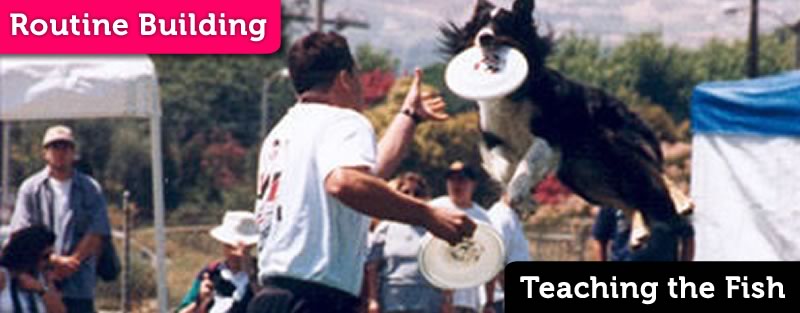
Ron Watson | Makai Woo
Around Clock that Resolves in a Heli In Flip

an Around Clockwise that resolves in a flip at the handler’s side. kneeling or standing, the Woo Flip is ripe for Fishing… This is a signature move by Ron Watson going back to 1997.
Keys to the Trick:
- PositionIn the Play+ philosophy, "Position" is the final stage within the "Next" phase of a Cycle of Play. It acts as a pivotal link between the "Next" phase and a new "Now" phase. More
- Target Placement & Timing
- Rhythm
Position – Take a Stand or Take a Knee
depending on your dog and your team or the type of visuals you’d like to demonstrate with this move you can choose to stand or kneel. each has advantages and disadvantages, and each are different.
In the kneeling position, handler movement is hard. Getting down there takes some time, getting up takes some time, and turning while on your knees ain’t exactly easy all the time. Throwing is limited as is catching (Fishing). The kneeling position does have some great positive attributes though:
- Dog above your head on catch
- face to face moment of truth on catch
- elevation change for sequence and routine purposes
Standing with this trick provides much more mobility but not all dogs have the ups to make it look good or feel comfy and flowy. Eppie flips pretty high and the Woos with him while I’m standing feel weak and, IMHO, don’t look nearly as good as kneeling.
Doing these with Kimo and Si I almost always did them standing. It was kind of hard getting the timing and placement right throwing that high from kneeling, I think… but we do have some sweet photos from back in the day from my knees… memories…

Target Placement and Timing – One and the Same
placement is more than just how far away and how high the disc is away. the most important part of placement in DiscDog is Time. the disc has to be not only in the right place but has to be there at the right time.
The timing of most moves can be dramatically simplified by taking time out of the equation altogether. To do that simply make the throw so that the dog leaves the ground for the Target. A clear cue followed by a clear, well defined trigger will enable the handler to deliver every disc so the dog leaves the ground for the Target.
Once the dog commits to the AroundAn Around, or a Go Around is the traditional disc dog set up move. The dog goes around the handler’s body in a clockwise or counter clockwise fashion allowing dog and handler to... More and starts to roll into the set up move Set Up Moves are tricks that are used to establish timing and position in disc dog freestyle. Traditional tricks include: Around, Through, Backwards Through, and Scoot, but any or all of your tricks,... More, make your throw. Set the throw above your left shoulder. It’s straight up and down, like a vault toss, and it should sit there and hover for a sec while the dog collects and finishes the Around with the intent to kill that disc.
Set Up Moves are tricks that are used to establish timing and position in disc dog freestyle. Traditional tricks include: Around, Through, Backwards Through, and Scoot, but any or all of your tricks,... More, make your throw. Set the throw above your left shoulder. It’s straight up and down, like a vault toss, and it should sit there and hover for a sec while the dog collects and finishes the Around with the intent to kill that disc.
Cuing, Rhythm, and Cadence
catch the rhythm of the Around and create a cadence: verbal cue, physical cue (your hand signal or leg/shoulders sliding back), and the toss – ready? boom – pow! this rhythm and cadence will lead to connection and commitment
Catching the rhythm isn’t hard if you can commit to throwing the disc so the dog leaves the ground to go get it. I like to give my verbal and pause to keep the dog honest, but when learning this skill I often purposefully develop a rhythm and pattern of timing and movement.
You should feel the dog commit and feel the dog coming around. The dog should be behind the handler looking at the target leaving the hand and should collect to go get that disc. The dog should enter into the skill with the intent to flip out of it. Creating a rhythm reinforces this idea.



